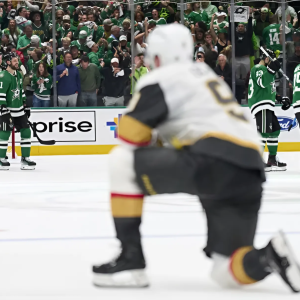TAMPA — Put down the tissues and grab your wits. Crying time is over, and you’re going to want to see this.
Two weeks after the saddest goodbye in franchise history, the Lightning are a different team. Less lovable but maybe more formidable. Less recognizable but more rational.

Steven Stamkos and Mikhail Sergachev are gone while curiosity and anticipation have returned. It’s sad when a front office decides a new direction is needed, but it’s also necessary when the team has been skating in circles for too long.
If the Lightning erred, it was in failing to act sooner.
Honestly, this was not a very good team in 2023-24. The defense was weak and the offense was the equivalent of a parlor trick. The Lightning were better than anyone when it came to the power play, but were among the worst in the league in your basic 5-on-5 situations.
That’s why Stamkos was offered less than he expected. That’s why Ryan McDonagh was brought back to rescue the defense. That’s why you’re looking at a roster where nearly one out of every three players needs an introduction.
Here’s the basic explanation for the Lightning facelift:
In 5-on-5 play, the Lightning were 25th in the NHL in scoring differential per 60 minutes. They were outscored 190-172 in 5-on-5, which is not what you expect from a playoff team and nowhere near what you need for a Stanley Cup contender.
That part was obvious. The difficulty was figuring out how to fix it.
It’s hard to explain this without making Stamkos sound like a scapegoat, but reality cannot be ignored. His contract had expired and he was coming off one of his least productive seasons, despite scoring 40 goals.
The analytics-based website Evolving Hockey uses puck possession, shot totals and the quality of shots to determine a player’s expected goals for/goals against statistic in 5-on-5 situations. Four years ago, Stamkos had a plus-0.45 in expected goals. Three years ago, it was plus-0.30. Two years ago, it dropped to plus-0.04. And last year, it went underwater at minus-0.33. That’s a clear warning sign that a player entering his mid-30s was beginning to slip.
The 40 goals were impressive, but nearly half (19) were on the power play. And the number of goals scored against the Lightning when Stamkos was on the ice was startling. In even-strength play, Stamkos had a minus-21 rating which was the worst of his 16-year career.
So the decision was made to offer Stamkos a contract that would be commensurate with a veteran who excelled on special teams, but would play a smaller role in even-strength situations.
Instead, the Lightning went after Jake Guentzel. In those Evolving Hockey stats, Guentzel was a minus-0.11 in expected goals four years ago. That improved to plus-0.46 and plus-0.43 the next two seasons before exploding to a plus-1.01 last year. While Stamkos, 34, was slipping, Guentzel, 29, is entering his prime. Which explains why he was one of the most sought-after free agents on the market.
To make salary cap space for Guentzel, the Lightning opted to deal Sergachev to Utah. While Sergachev, 26, has a grand future ahead of him, his best qualities as a defenseman were his ability to bring the puck up the ice and run the power play. With McDonagh, and presumably J.J. Moser who came from Utah in the trade, the emphasis will be more on stopping goals than pushing the puck.

The Lightning also revamped its group of role players. Gone are Tanner Jeannot, Tyler Motte and Calvin de Haan, along with rentals Mathew Dumba and Anthony Duclair. In their place are Cam Atkinson, Girgensons Zemgus and Jesse Ylonen, along with younger players such as Emil Lilleberg, who will see more playing time.
Essentially, each move was made to make the Lightning a tougher team to play in 5-on-5 situations. The makeover is somewhat similar to what the Lightning went through in 2019-20 when they evolved from a high-scoring circus act to a team that put defense first. Back then, the changes were in mindset and strategy (along with trade deadline acquisitions Blake Coleman and Barclay Goodrow) while this is more of a reprioritizing of assets.
So are the Lightning a better team today? I would think so.
General manager Julien BriseBois did not do a complete teardown, but he recognized that the Lightning were trending in the wrong direction. It was painful. It was somewhat risky. But for a team that has not yet let go of Stanley Cup aspirations, it was necessary.





